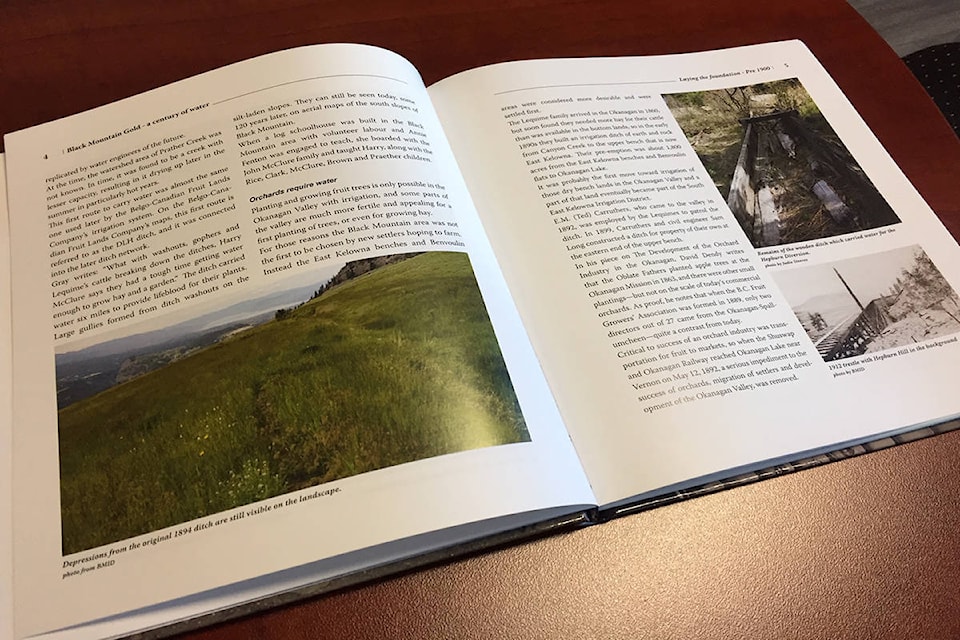A new historical book has captured the ingenuity and dedication behind the Black Mountain Irrigation District.
Titled Black Mountain Gold - A Century of Water, the book is the story behind the first century of a water utility started by original Central Okanagan pioneers, with names such as Rutland, Casorso, Lequime, Mugford, Philpott, Stevens – individuals and families who played significant roles in the overall development of Kelowna into the city it is today.
The book, written by former Capital News long-time environment and outdoors reporter Judie Steeves, recounts the history behind the irrigation district, a landmark publication to help mark the Black Mountain Irrigation District’s (BMID) 100th anniversary.
| Remains of an original Black Mountain Irrigation District concrete-lined ditch used to distribute water. (Contributed) |
Along with the book release, a ceremony to recognize the anniversary coupled with tours of the BMID’s state-if-the-art ultra-violet disinfection facility, 2450 Joe Rich Rd., was slated for Saturday, Dec. 5. However, those activities all had to be cancelled due to COVID-19 public gathering restrictions imposed by the provincial health office in recent weeks.
“We are looking now to have some kind of grand opening for the (disinfection facility) at some time next spring,” said Bob Hrasko, administrator of the BMID.
Hrasko said the book was a communal effort assisted by many people, a process that started in earnest about 18 months ago.
READ MORE: City of Kelowna exerts its own type of pressure on irrigation districts
Serving on the book research committee along with Hrasko were John and Evelyn Vielvoye, Lynn Stevens, Elaine Singer and retired former MP and MLA Al Horning.
Others involved in the research process included historical geographer Wayne Wilson, Bob Hayes and others with the Okanagan Historical Society as well as Ted White, comptroller of water for the province.
“Al Horning is the guy who actually was the most important person that caused the book to happen,” Hrasko recounted.
“He bugged me about it 10 years ago, then again three years ago, saying the 100th year anniversary is coming up and we need to do something…I don’t think it would have happened if he had not pushed for it at the outset.”
He added the 105-page literary effort had the sponsorship support of about 35 businesses, to help hold the cost to $25. It is now available for sale at Mosaic Books in downtown Kelowna.
He said BMID’s story is a historically fascinating one, a reflection of the development across the valley, guided by settlers’ innovation to bring water to their plots of land, their lobbying efforts for assistance from senior government levels to enact laws or build infrastructure to make forward movement possible, along with the politics involved along the way.
Hrasko says those trademarks of the BMID’s history continue today, as the water irrigation district stands as evidence to why consolidating the management of water under the auspices of the City of Kelowna may not serve the best interests of domestic and agricultural water users it serves.
It remains a politically sensitive issue today. With a push from the province, efforts to pursue the consolidation avenue had reached a compromise agreement with the various water districts in 2012, to the point where 40 different water enhancement projects were identified to proceed on.
But that fell apart in 2017, while the city has since taken over the Southeast Kelowna Irrigation District and completed a $98 million infrastructure enhancement upgrade project.
Still, the first 19 of those 40 projects have been done, and Hrasko remains optimistic number 20 to improve water delivery inter-connectivity between the various water purveyors will proceed.
While increased water quality demands have placed prohibitive infrastructure demands on independent water districts, Hrasko points to the new ultra-violet disinfection plant as the BMID’s ability to provide quality water distribution to its users, with further distribution enhancement projects in the works, all while meeting Interior Health enforced water quality guidelines.
He said the BMID’s reputation for the quality of water is a reflection of not pumping water from the lake, but having access to natural water runoff free of pollutants, reflected in reservoirs it has 25-feet deep where you can see the bottom from the reservoir bank.
Adding to that, he said, is the level of commitment to concerns or issues posed by irrigation water users and helping to encourage water conservation initiatives as people become increasingly conscious of protecting a sustainable water resource for years to come in the shadow of climate change and increased urban development impacts.
Like us on Facebook and follow us on Twitter.